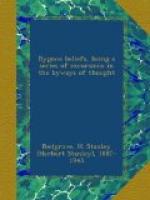This search for unity in multiplicity, however, is not confined to the acknowledged scientist and philosopher. More or less unconsciously everyone is engaged in this quest. Harmony and unity are the very fundamental laws of the human mind itself, and, in a sense, all mental activity is the endeavour to bring about a state of harmony and unity in the mind. No two ideas that are contradictory of one another, and are perceived to be of this nature, can permanently exist in any sane man’s mind. It is true that many people try to keep certain portions of their mental life in water-tight compartments; thus some try to keep their religious convictions and their business ideas, or their religious faith and their scientific knowledge, separate from another one—and, it seems, often succeed remarkably well in so doing. But, ultimately, the arbitrary mental walls they have erected will break down by the force of their own ideas. Contradictory ideas from different compartments will then present themselves to consciousness at the same moment of time, and the result of the perception of their contradictory nature will be mental anguish and turmoil, persisting until one set of ideas is conquered and overcome by the other, and harmony and unity are restored.
It is true of all of us, then, that we seek for Unity—unity in mind and life. Some seek it in science and a life of knowledge; some seek it in religion and a life of faith; some seek it in human love and find it in the life of service to their fellows; some seek it in pleasure and the gratification of the senses’ demands; some seek it in the harmonious development of all the facets of their being. Many the methods, right and wrong; many the terms under which the One is conceived, true and false—in a sense, to use the phraseology of a bygone system of philosophy, we are all, consciously or unconsciously, following paths that lead thither or paths that lead away, seekers in the quest of the Philosopher’s Stone.
Let us, in these excursions in the byways of thought, consider for a while the form that the quest of fundamental unity took in the hands of those curious mediaeval philosophers, half mystics, half experimentalists in natural things—that are known by the name of “alchemists.”




